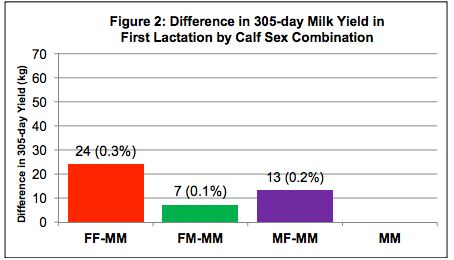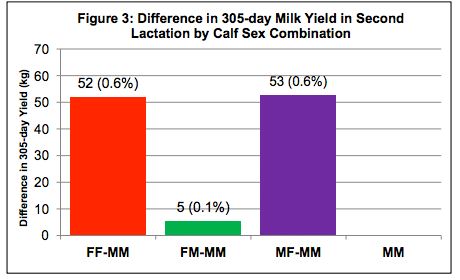



Is Sex-Biased Milk Production a Real Thing?
A team of Canadian researchers scrutinises the latest thinking on calf sex and lactation yield, affirming that more milk usually follows heifer calves.Brian Van Doormal, General Manager at the Canadian Dairy Network (CDN) with colleague Lynsay Beavers, have confirmed the theories but do caveat that the increase, specifically across the first two lactations, is marginal.
What follows is a summary of Canadian data from the CDN concluding that improvement in yield does not class as one of the many reasons to use sexed semen.
Is Sex-Biased Milk Production a Real Thing?
Tell a dairy farmer there’s an easy way to increase milk production by nearly 450 kg over the first two lactations, and you’ve got their attention! In a recent scientific paper (see reference below), researchers using DHI data in United States claimed just this.
The authors hypothesized that milk production in first lactation is affected by the sex of the calf produced, but also by the sex of the fetus gestated during that lactation. They further predicted that the udder’s capacity to synthesize milk across all lactations is influenced by the sex of the first fetus, with females being advantageous. Canadian Dairy Network (CDN) performed a similar analysis using Canadian data to see if results were consistent.
CDN Analysis
Using Canadian data for lactations from cows that calved between 2001 and 2013, information was restricted to only individual births associated with lactations one to five where the sex of calf was recorded. Overall, 5.4 million lactations from 2.5 million cows were included in the analysis. Heifer and bull calves were represented in nearly equal ratios for calvings associated with each lactation.
Effect of Calf Sex on Subsequent Lactation Milk Production
As presented in Figure 1, 305-day milk yield was higher in each lactation following a calving that resulted in a heifer calf compared to a bull calf. Lactation yields following the birth of a heifer calf were 60-70 kg higher for the first two calvings and slightly more than 100 kg for later calvings. The higher production differences associated with later lactations are expected given the general increased production capability associated with older cows. Yields of fat and protein followed a similar pattern as for milk production, therefore keeping percentages unchanged.
Effect of Calf Sex on First and Second Lactation Production
A subset of data was used to examine the effects of calf sex combinations on first and second lactation milk yields. Since production is reduced following a difficult calving, the analysis was restricted to only include calvings that were reported as unassisted, unobserved or an easy pull.
This group of 210,099 cows was divided into four categories based on the various combinations of sex of calf at first and second lactation. Cows with two consecutive female calves were labelled as “FF” and those with two consecutive male calves were “MM”, which was used as the base group of cows for comparison. Other cows were grouped as “FM” or “MF” according to the sex of their first and second calves.
As shown in Figure 2, milk yield in first lactation was higher for cows that had given birth to a heifer calf and were then pregnant again in first lactation with another heifer. Cows that fit into this category produced 0.3 per cent (24 kg) more milk in their first lactation (305 days) than cows that gave birth to a bull calf and were pregnant with another male. Any effect of carrying a heifer during the cow’s first pregnancy was essentially eliminated when the second pregnancy (i.e.: during first lactation) resulted in a male calf (FM-MM). Carrying a heifer calf during the first lactation pregnancy did show some increase in first lactation production but very small at 13 kg.
For 305-day milk yield in second lactation, the sex of the first pregnancy had no effect, as seen by comparing FF-MM versus MF-MM (1 kg difference) in Figure 3 as well as FM-MM versus MM (5 kg difference). Second lactation production was improved, however, by 0.6 per cent (52-53 kg over 305 days) for cow’s that gave birth to a heifer to initiate that lactation compared to cow’s with a male calf at second calving.
For the first two lactations, the cumulative benefit of having two consecutive heifers compared to male calves (FF-MM in Figures 2 and 3) amounts to an increase of 76 kg (0.4 per cent ). This is much lower than the value reported in the US study, which claimed a two-lactation benefit of 2.7 per cent and 445 kg. Authors in the US state that the marginal increase in production after gestating a heifer calf could be related to circulating hormones, which differ in male and female fetuses and in maternal circulation during pregnancy.
The Case for Sexed Semen
Sexed semen provides an array of benefits: more heifer replacements, easier calvings and the opportunity for increased genetic progress. In addition, the analysis by CDN shows that using sexed semen to produce more pregnancies with a heifer calf, instead of bull calves, can lead to an increase in milk production. However, it is important to note that this increase is very small at less than 0.5 per cent across the first two lactations. There are many good reasons to use sexed semen, but increased production is so marginal, it can hardly qualify as one of them.
Authors: Lynsay Beavers and Brian Van Doormaal Date: March 2014
Reference: Hinde K., Carpenter A.J., Clay J.S., Bradford B.J. (2014) Holsteins Favor Heifers, Not Bulls: Biased Milk Production Programmed during Pregnancy as a Function of Fetal Sex. PLoS ONE 9(2): e86169. doi:10.1371/journal.pone.0086169




